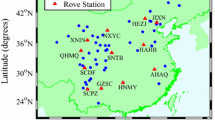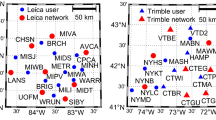Abstract
The key issue to enable precise point positioning with ambiguity resolution (PPP-AR) is to estimate fractional-cycle biases (FCBs), which mainly relate to receiver and satellite hardware biases, over a network of reference stations. While this has been well achieved for GPS, FCB estimation for GLONASS is difficult because (1) satellites do not share the same frequencies as a result of Frequency Division Multiple Access (FDMA) signals; (2) and even worse, pseudorange hardware biases of receivers vary in an irregular manner with manufacturers, antennas, domes, firmware, etc., which especially complicates GLONASS PPP-AR over inhomogeneous receivers. We propose a general approach where external ionosphere products are introduced into GLONASS PPP to estimate precise FCBs that are less impaired by pseudorange hardware biases of diverse receivers to enable PPP-AR. One month of GLONASS data at about 550 European stations were processed. From an exemplary network of 51 inhomogeneous receivers, including four receiver types with various antennas and spanning about 800 km in both longitudinal and latitudinal directions, we found that 92.4 % of all fractional parts of GLONASS wide-lane ambiguities agree well within \(\pm \)0.15 cycles with a standard deviation of 0.09 cycles if global ionosphere maps (GIMs) are introduced, compared to only 51.7 % within \(\pm \)0.15 cycles and a larger standard deviation of 0.22 cycles otherwise. Hourly static GLONASS PPP-AR at 40 test stations can reach position estimates of about 1 and 2 cm in RMS from ground truth for the horizontal and vertical components, respectively, which is comparable to hourly GPS PPP-AR. Integrated GLONASS and GPS PPP-AR can further achieve an RMS of about 0.5 cm in horizontal and 1–2 cm in vertical components. We stress that the performance of GLONASS PPP-AR across inhomogeneous receivers depends on the accuracy of ionosphere products. GIMs have a modest accuracy of only 2–8 TECU (Total Electron Content Unit) in vertical which confines PPP-AR to an approximately \(800\times 800\) km area in Europe. We expect that a regional ionosphere map with a better than 1 TECU accuracy is likely to improve the GLONASS PPP-AR efficiency.







Similar content being viewed by others
References
Al-Shaery A, Zhang S, Rizos C (2013) An enhanced calibration method of GLONASS inter-channel bias for GNSS RTK. GPS Solut 17(2):165–173
Banville S, Collins P, Lahaye F (2013a) Concepts for undifferenced GLONASS ambiguity resolution. In: Proceedings of ION GNSS 26th international technical meeting of the Satellite Division. Nashville, TN, pp 1186–1197
Banville S, Collins P, Lahaye F (2013b) GLONASS ambiguity resolution of mixed receiver types without external calibration. GPS Solut 17(3):275–282
Bertiger W, Desai SD, Haines B, Harvey N, Moore AW, Owen S, Weiss JP (2010) Single receiver phase ambiguity resolution with GPS data. J Geod 84(5):327–337
Bruyninx C (2004) The EUREF Permanent Network: a multi-disciplinary network serving surveyors as well as scientists. GeoInformatics 7(5):32–35
Cai C, Gao Y (2013) Modeling and assessment of combined GPS/GLONASS precise point positioning. GPS Solut 17(2):223–236
Collins P, Bisnath S, Lahaye F, Héroux P (2010) Undifferenced GPS ambiguity resolution using the decoupled clock model and ambiguity datum fixing. J Inst Navig 57(2):123–135
Dach R, Hugentobler U, Fridez P, Meindl M (eds) (2007) Bernese GPS software version 5.0. Astronomical Institute, University of Bern, Bern, p 612
Dach R, Schmid R, Schmitz M, Thaller D, Schaer S, Lutz S, Steigenberger P, Wübbena G, Beutler G (2011) Improved antenna phase center models for GLONASS. GPS Solut 15(1):49–65
Dilssner F, Springer T, Flohrer C, Dow J (2010) Estimation of phase center corrections for GLONASS-M satellite antennas. J Geod 84(8):467–480
Dilssner F, Springer T, Gienger G, Dow J (2011) The GLONASS-M satellite yaw-attitude model. Adv Space Res 47(1):160–171
Dong D, Bock Y (1989) Global positioning system network analysis with phase ambiguity resolution applied to crustal deformation studies in California. J Geophys Res 94(B4):3949–3966
Dow JM, Neilan RE, Rizos C (2009) The international GNSS service in a changing landscape of global navigation satellite systems. J Geod 83(3–4):191–198
Durmaz M, Karslioglu MO (2015) Regional vertical total electron content (VTEC) modeling together with satellite and receiver differential code biases (DCBs) using semi-parametric multivariate adaptive regression B-splines (SP-BMARS). J Geod 89(4):347–360
Eren K, Uzel T (2009) CORS-TR Project (Final Report). Tech. rep., Istanbul Kultur University, Istanbul, Turkey (in Turkish)
Euler HJ, Schaffrin B (1990) On a measure of the discernibility between different ambiguity solutions in the static-kinematic GPS mode. In: Schwarz KP, Lachapelle G (eds) Kinematic systems in geodesy, surveying and remote sensing. Springer-Verlag, New York, pp 285–295
Ge M, Gendt G, Rothacher M, Shi C, Liu J (2008) Resolution of GPS carrier-phase ambiguities in precise point positioning (PPP) with daily observations. J Geod 82(7):389–399
Geng J, Teferle FN, Shi C, Meng X, Dodson AH, Liu J (2009) Ambiguity resolution in precise point positioning with hourly data. GPS Solut 13(4):263–270
Geng J, Meng X, Dodson AH, Ge M, Teferle FN (2010a) Rapid re-convergences to ambiguity-fixed solutions in precise point positioning. J Geod 84(12):705–714
Geng J, Meng X, Dodson AH, Teferle FN (2010b) Integer ambiguity resolution in precise point positioning: method comparison. J Geod 84(9):569–581
Geng J, Teferle FN, Meng X, Dodson AH (2011) Towards PPP-RTK: ambiguity resolution in real-time precise point positioning. Adv Space Res 47(10):1664–1673
Geng J, Shi C, Ge M, Dodson AH, Lou Y, Zhao Q, Liu J (2012) Improving the estimation of fractional-cycle biases for ambiguity resolution in precise point positioning. J Geod 86(8):579–589
Hauschild A, Montenbruck O (2014) A study on the dependency of GNSS pseudorange biases on correlator spacing. GPS Solut. doi:10.1007/s10291-014-0426-0
Hernández-Pajares M, Juan JM, Sanz J, Orús R, Garcia-Rigo A, Feltens J, Komjathy A, Schaer SC, Krankowski A (2009) The IGS VTEC maps: a reliable source of ionospheric information since 1998. J Geod 83(3–4):263–275
Kouba J (2009) A simplified yaw-attitude model for eclipsing GPS satellites. GPS Solut 13(1):1–12
Laurichesse D, Mercier F, Berthias JP, Broca P, Cerri L (2009) Integer ambiguity resolution on undifferenced GPS phase measurements and its application to PPP and satellite precise orbit determination. J Inst Navig 56(2):135–149
Melbourne WG (1985) The case for ranging in GPS-based geodetic systems. In: Proceedings of first international symposium on precise positioning with the Global Positioning System, Rockville, MD, pp 373–386
Reussner N, Wanninger L (2011) GLONASS inter-frequency biases and their effects on RTK and PPP carrier-phase ambiguity resolution. In: Proceedings of ION GNSS 24th international technical meeting of the Satellite Division, Portland, OR, pp 712–716
Reussner N, Wanninger L (2012) GLONASS inter-frequency code biases and PPP carrier-phase ambiguity resolution. IGS workshop 2012, Olsztyn, Poland, 23–27 Jul
Schaer S (2008) Differential code biases (DCB) in GNSS analysis. IGS workshop 2008, Miami Beach, FL, USA, 2–6 June
Schaffrin B, Bock Y (1988) A unified scheme for processing GPS dual-band phase observations. Bulletin Géodésique 62(2):142–160
Shi C, Yi W, Song W, Lou Y, Yao Y, Zhang R (2013) GLONASS pseudorange inter-channel biases and their effects on combined GPS/GLONASS precise point positioning. GPS Solut 17(4):439–451
Sleewaegen JM, Simsky A, De Wilde W, Boon F, Willems T (2012) Demystifying GLONASS inter-frequency carrier phase biases. Inside GNSS 7(3):57–61
Takac F (2009) GLONASS inter-frequency biases and ambiguity resolution. Inside GNSS 4(2):24–28
Teunissen PJG (1995) The least-squares ambiguity decorrelation adjustment: a method for fast GPS integer ambiguity estimation. J Geod 70(1–2):65–82
Teunissen PJG, Khodabandeh A (2015) Review and principles of PPP-RTK methods. J Geod 89(3):217–240
Wang J (2000) An approach to GLONASS ambiguity resolution. J Geod 74(5):421–430
Wanninger L (2012) Carrier-phase inter-frequency biases of GLONASS receivers. J Geod 86(2):138–148
Wübbena G (1985) Software developments for geodetic positioning with GPS using TI-4100 code and carrier measurements. In: Proceedings of first international symposium on precise positioning with the Global Positioning System, Rockville, MD, pp 403–412
Wübbena G, Schmitz M, Bagge A (2005) PPP-RTK: precise point positioning using state-space representation in RTK networks. In: Proceedings of ION GNSS 18th international technical meeting of the Satellite Division, Long Beach, US, pp 2584–2594
Yamada H, Takasu T, Kubo N, Yasuda A (2010) Evaluation and calibration of receiver inter-channel biases for RTK-GPS/GLONASS. In: Proceedings of ION GPS/GNSS 23rd international technical meeting of the Satellite Division, Portland, OR, pp 1580–1587
Zhang B, Teunissen PJG, Odijk D, Ou J, Jiang Z (2012) Rapid integer ambiguity-fixing in precise point positioning. Chin J Geophys 55(7):2203–2211 (in Chinese)
Zumberge JF, Heflin MB, Jefferson DC, Watkins MM, Webb FH (1997) Precise point positioning for the efficient and robust analysis of GPS data from large networks. J Geophys Res 102(B3):5005–5017
Acknowledgments
We are indebted to S. Bakici and R.M. Alkan for the GPS/GLONASS data from Turkey Reference Station Network (TUSAGA-AKTIF, cors-tr.iku.edu.tr), and to Nottingham Geospatial Institute and D. Hansen for the data from the Natural Environment Research Council (NERC) British Isles continuous GNSS Facility (BIGF, http://www.bigf.ac.uk). Sleewaegen provided the IFB for Septentrio PolaRx4 receivers. We are also grateful for the data provided by EUREF (http://www.epncb.oma.be) and NOANET (http://www.gein.noa.gr). We thank IGS for the final orbit, clock, GIM and DCB products which ensure the success of this study. The work is funded by NASA Grants (NNX12AK24G, NNX14AQ53G).
Author information
Authors and Affiliations
Corresponding author
Rights and permissions
About this article
Cite this article
Geng, J., Bock, Y. GLONASS fractional-cycle bias estimation across inhomogeneous receivers for PPP ambiguity resolution. J Geod 90, 379–396 (2016). https://doi.org/10.1007/s00190-015-0879-0
Received:
Accepted:
Published:
Issue Date:
DOI: https://doi.org/10.1007/s00190-015-0879-0




